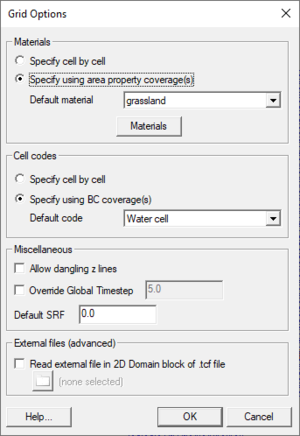SMS:TUFLOW Grid Options: Difference between revisions
No edit summary |
No edit summary |
||
| Line 1: | Line 1: | ||
[[Image:TUFLOW Grid Options.jpg|thumb|300 px|TUFLOW ''Grid Options'' dialog]] | [[Image:TUFLOW Grid Options.jpg|thumb|300 px|TUFLOW ''Grid Options'' dialog]] | ||
The TUFLOW ''Grid Options'' dialog (right-click on | The TUFLOW ''Grid Options'' dialog (right-click on 2D geometry component in the project explorer and select '''Options''') is used to specify how TUFLOW will handle the grid data. Some of the options deal with what types of data will be specified on the grid cells. This data can alternatively be specified using coverages and this has several advantages including size of the data, speed of execution, and more opportunities for reuse. | ||
The general options include: | The general options include: | ||
| Line 7: | Line 7: | ||
* Override Global Timestep | * Override Global Timestep | ||
* External Files (Advanced) | * External Files (Advanced) | ||
** [[SMS:Read external file | Read | ** [[SMS:Read external file | Read External File in *.tgc file]] – This can be used to read an external file from the TUFLOW *.tgc file. | ||
** Read External File in 2D Domain block of *.tcf file. | ** Read External File in 2D Domain block of *.tcf file. | ||
*Materials | *Materials | ||
| Line 18: | Line 18: | ||
• Time step – Since the required time step depends heavily on the size of grid cells, it is often convenient for each grid to have a unique time step when using multiple grids in a simulation. These controls allow the user to override the global time step on a grid by grid basis. | • Time step – Since the required time step depends heavily on the size of grid cells, it is often convenient for each grid to have a unique time step when using multiple grids in a simulation. These controls allow the user to override the global time step on a grid by grid basis. | ||
The rest of the dialog is used to tell SMS what kind of data to write from the grid in SMS. The optional data types are materials and cell codes. Materials may be specified | The rest of the dialog is used to tell SMS what kind of data to write from the grid in SMS. The optional data types are materials and cell codes. Materials may be specified using an area property coverage and cell codes can be specified from polygons in a TUFLOW BC Coverage. If a grid (instead of a TUFLOW grid extents coverage) is being used in the geometry component, these properties can also be specified cell by cell. If using an area property coverage, a default material is specified for any areas not inside of a polygon. | ||
==Related Topics== | ==Related Topics== | ||
Revision as of 20:16, 14 June 2013
The TUFLOW Grid Options dialog (right-click on 2D geometry component in the project explorer and select Options) is used to specify how TUFLOW will handle the grid data. Some of the options deal with what types of data will be specified on the grid cells. This data can alternatively be specified using coverages and this has several advantages including size of the data, speed of execution, and more opportunities for reuse.
The general options include:
- Allowing dangling z lines – This turns on/off the TUFLOW command to check for dialing z lines (see the TUFLOW manual for description).
- Override Global Timestep
- External Files (Advanced)
- Read External File in *.tgc file – This can be used to read an external file from the TUFLOW *.tgc file.
- Read External File in 2D Domain block of *.tcf file.
- Materials
- Specify cell by cell
- Specify using area property coverage(s)
- Cell Codes
- Specify cell by cell
- Specify using BC coverage(s)
• Time step – Since the required time step depends heavily on the size of grid cells, it is often convenient for each grid to have a unique time step when using multiple grids in a simulation. These controls allow the user to override the global time step on a grid by grid basis.
The rest of the dialog is used to tell SMS what kind of data to write from the grid in SMS. The optional data types are materials and cell codes. Materials may be specified using an area property coverage and cell codes can be specified from polygons in a TUFLOW BC Coverage. If a grid (instead of a TUFLOW grid extents coverage) is being used in the geometry component, these properties can also be specified cell by cell. If using an area property coverage, a default material is specified for any areas not inside of a polygon.
Related Topics
SMS – Surface-water Modeling System | ||
|---|---|---|
| Modules: | 1D Grid • Cartesian Grid • Curvilinear Grid • GIS • Map • Mesh • Particle • Quadtree • Raster • Scatter • UGrid |  |
| General Models: | 3D Structure • FVCOM • Generic • PTM | |
| Coastal Models: | ADCIRC • BOUSS-2D • CGWAVE • CMS-Flow • CMS-Wave • GenCade • STWAVE • WAM | |
| Riverine/Estuarine Models: | AdH • HEC-RAS • HYDRO AS-2D • RMA2 • RMA4 • SRH-2D • TUFLOW • TUFLOW FV | |
| Aquaveo • SMS Tutorials • SMS Workflows | ||
